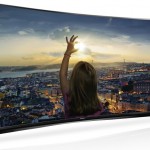Panasonic 4K Pro: Finally get to see what the director REALLY intended
 Panasonic today announced the introduction of ‘4K Pro’: an enhanced 4K experience that combines the professional-level processing power of Panasonic’s new 4K Studio Master Processor with super-bright Wide Colour Phosphor panels that cover a maximum of 98% of the Digital Cinema Initiative (DCI) colour range.
Panasonic today announced the introduction of ‘4K Pro’: an enhanced 4K experience that combines the professional-level processing power of Panasonic’s new 4K Studio Master Processor with super-bright Wide Colour Phosphor panels that cover a maximum of 98% of the Digital Cinema Initiative (DCI) colour range.
Because of the limitations of traditional TV technology, viewers have long had to accept that it is difficult to experience at home what film directors truly intended when they put together their masterpieces.
However, Panasonic’s guiding principle with regards to TV picture quality has always been to strive to faithfully reproduce the director’s vision. 4K Pro represents a considerable step towards casting aside past screen limitations and is made possible by a cross-fertilisation of Panasonic’s professional AV business technology with the ‘reference’ picture quality knowhow built up while developing its renowned plasma TVs.
What is 4K Pro?
For Panasonic, 4K resolution is just one part of an immersive and accurate picture experience. So while the new 4K Pro picture engine certainly maximises the impact of 4K’s 3840×2160 pixel count, it also deploys a whole raft of technologies – including both panel design and processing systems – to address all the other key aspects of TV picture quality too.
The 4K Studio Master Processor
Panasonic’s proprietary 4K Studio Master Processor has been designed from the ground up to produce pictures that are totally faithful to a director’s vision. It draws on the huge resource of picture knowledge accumulated by Panasonic’s internationally respected professional AV business, the Panasonic Hollywood Laboratory, and its plasma TV division to deliver unprecedentedly accurate colour, uniquely satisfying contrast, and phenomenal brightness and dynamism.
Accurate Colour Drive: Through its Accurate Colour Drive, Panasonic has introduced to consumer TVs advanced colour management technologies, such as 3D Lookup Tables, which have previously only found in professional monitors.
3D Lookup Tables provide a volumetric approach to colour space control whereby a change in any one input colour causes cross-colour changes in all of the table’s output colours. The result is a much more accurate rendition of colour tones at different brightness levels than you get with normal TVs, which conventionally employ either very crude or no lookup table technology.
Even screens that do offer 3D Lookup Table usually only offer red, green and blue control, whereas on the Panasonic CR850 and CX800 TVs the table also references the cyan, magenta and yellow colours across a total of 8000 registry points (versus a typical 100). This enables the Panasonic TVs to provide the sort of professional-grade colour accuracy used by directors when they’re editing their films.
Black Gradation Drive: Normally LCD TVs control their backlights and gain settings separately, using 8-bit processing to deliver 256 steps of gradation. With its 4K Studio Master Processor though, Panasonic has brought the backlight control and gain adjustment picture controls together under the same processing umbrella for the first time, so that they can work in tandem to deliver more accurate local light levels. What’s more, it uses 10-bit driving to produce 1024 steps of gradation. What this means in picture terms is that you see vastly more shadow detail and subtler, more accurate colour toning in dark parts of the picture, avoiding that hollow, flat, washed-out look commonly seen with dark scenes on normal LCD TVs.
Native HDR Content playback: the 4K Studio Master Processor is enabled to support the playback of native High Dynamic Range (HDR) content when the appropriate standards have been finalized. HDR uses a combination of specially created content and super-bright, colour-rich screens to deliver images containing a much wider luminance range than any traditional TV. This means you can enjoy pictures with more contrast, richer colours, and greatly enhanced shadow and colour detail.
Wide Colour Phosphor Panels
The second key 4K Pro element in the Panasonic CR850 and CX800 TVs is their use of LED panels which include new Wide Colour Phosphor technology and have been custom built to complement the work of the Panasonic 4K Studio Master Processor. Thanks to the Wide Colour Phosphor technology, these panels can reproduce a remarkable 98% of the Digital Cinema Initiative (DCI) colour space.
Coupling these spectacular new panels with the 4K Studio Master Processor translates into you being able to see a range of colours on your TV much closer in tone and subtlety – especially in areas of red and green – to those you would see if you went to see a film at your local cinema. In other words, once again Panasonic TVs are uniquely well qualified to let you enjoy pictures at home that look almost exactly the way directors wanted them to look when they shot them.
Bright and Eco-conscious: As well as helping colours achieve a more cinematic range, Wide Colour Phosphor technology has considerable brightness and eco benefits. For instance, it uses approximately only half the energy of a conventional Quantum Dot panel to produce the same level of brightness, making it extremely cost effective to run. This makes Wide Colour Phosphor technology ideally suited to the playback of High Dynamic Range content.







No Trackbacks.